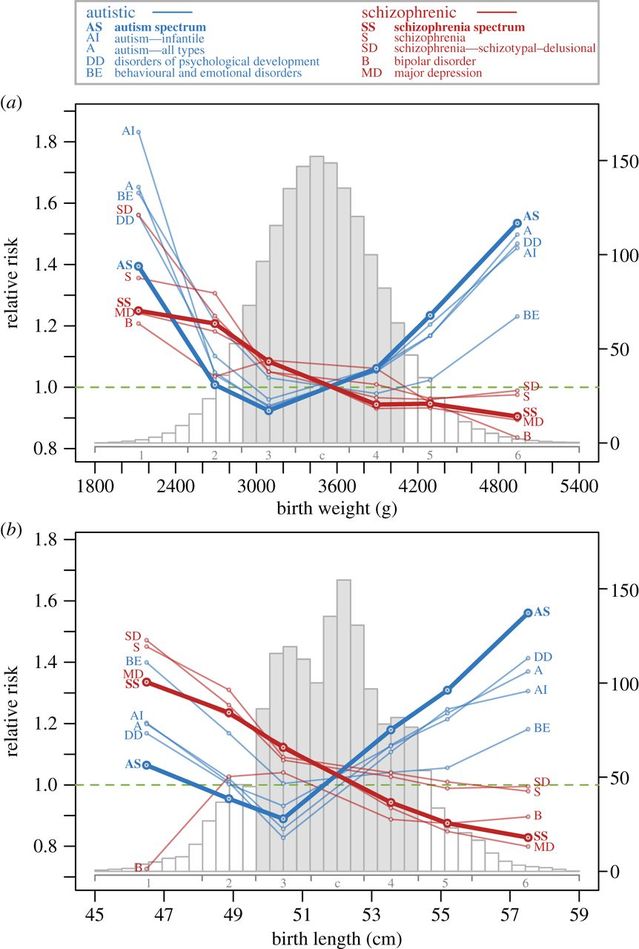Autism
Birth Size Inversely Varies Risk of Autism v. Schizophrenia
Danish data strikingly endorse the imprinted brain theory’s principal claims.
Posted September 17, 2014

Although much indirect corroborative evidence has accumulated over the years since the imprinted brain theory was first published—most of it flagged up in these posts—a major frustration has been the lack of studies directly comparing autistic with psychotic disorders. But now Sean Byars, Stephen Stearns, and Jacobus Boomsma have sensationally remedied the situation. These researchers analyzed health registry data for approximately 5 million Danish residents to detect opposing risks of autism and schizophrenia depending on normal variation in birth size, as suggested by their illustration above. They used birth size as a proxy for the expression of oppositely acting maternal versus paternal imprinted genes during gestation because paternal genes are known to enhance growth and maternal ones to restrict it. They limited the birth size range to 1 standard deviation of mean birth size (shaded areas below) to avoid confounding pathological effects at the extremes (for example, prematurity). In this figure illustrating their findings, red lines represent risk of what the authors call schizophrenia-spectrum (SS) and blue lines autism-spectrum (AS) disorders according to birth weight and length by frequency (x1000) on the right y-axis.

The researchers identified 1,757,770 singleton live births between January 1978 and January 2009 in the Danish Fertility Database which met their criteria for completeness of information and representativeness. Of these, 95,345 (5.42%) had an autistic, schizophrenic or related disorder. The authors report that
The results of our study consistently support the Badcock and Crespi hypothesis that autism and schizophrenia are opposite extremes of a single gradient of mental disorders. This is remarkable, for the inclusive fitness theory that produced these predictions was initially blind to any clinical applications and remains at present the only theory that predicts the diametrically opposed risk patterns that our study uncovered.
The authors report that “Our results lend credibility to Badcock & Crespi’s idea that the opposed risk factors will at least partly be due to diametric gene-dosage deviations caused by disrupted genomic imprinting or copy number variants.” However, they add that “this support is indirect. We still lack most of the genetic evidence needed to understand which genes became subject to parent-of-origin imprinting and why other genes escaped that fate, but the evidence available so far seems encouraging.”
Regarding the imprinted brain theory’s prediction “that disturbances in paternal and maternal gene-dosage deviations should directionally increase or decrease risks of specific psychiatric disorders outwards from the centre of average birth size and normal cognition,” the researchers report that
Our results testing the full birth size range mostly supported this prediction. AS risk (and other related behaviours) continued to increase with increasing birth weight and length, and SS risk (and related behaviours) continued to increase with decreasing birthweight and length.
This pattern was consistent across the entire birth length range, but at extremely low birth weight, the autism versus psychosis opposition became less clear. The authors point out that “this is consistent with earlier findings that abnormal gestations resulting in very low birth sizes may be harmful for brain development in general, increasing the risks for many psychiatric disorders irrespective of imprinting or copy number predispositions that may bias risk in a specific direction when birth size is closer to the population mean.”
As to whether these patterns were supported across the range of autistic versus schizophrenic disorders, the authors report that as the figure above illustrates,
this appeared to be the case, with remarkably few exceptions. This level of coherence also suggests that the results that we obtained are robust in spite of ongoing discussions among clinicians on how best to categorize and refine diagnoses of mental disease.
The final issue they addressed related to the extent to which other known risk factors affect the hypothesized opposition of autism and schizophrenia, and here the researchers “found a consistent effect of paternal age on risk of both autistic and schizophrenic-related disorders,” in line with my comments in an earlier post. However, the authors add that their “finding that first-born children have an elevated risk of autistic diagnoses later in life suggests that the relationship between risk of psychiatric disorders and maternal age may be U-shaped.”
Additionally, because gestational hypertension is caused by paternal genes in the fetus/placenta, the authors add that “Maternal hypertension during pregnancy significantly increased risk for all autistic (but not schizophrenic) disorders,” just as the imprinted brain theory predicts. Indeed, the tabulated data suggest that the same is true of another paternally-induced symptom of pregnancy: gestational diabetes.
Contrary to conventional wisdom, the imprinted brain theory implies that males should suffer more from autistic conditions and females more from psychotic ones. But here again the present study—one of enormous statistical significance, given the huge size of its sample population—confirms the implication, with the authors remarking that “Autistic disorders tended to be higher in male offspring and schizophrenic disorders more prevalent in female offspring, except for two groups (schizophrenia, schizophrenia–schizotypal–delusional disorders) that were higher in males.” The authors point out that differences between the sexes in severity and age of onset might explain this, with schizophrenia being more severe in males and perhaps having an earlier onset than in females, including a second peak for women aged 45–79 which their 30-year span of data could not cover completely.
Finally, the study notes that two main caveats should be borne in mind: First, the diametric pattern predicted by the imprinted brain theory “is only one, albeit a very coherent, factor contributing to the causation and prevalence of autism and schizophrenia. The finding that many other variables we included also contributed significant risk to both disorders (…) echoes this.”
But of course, the theory never proposed that imprinted genes were the only factor, simply that they were a major one in explaining the genetic/epigenetic predisposition to mental illness. This study had to ignore the other class of genes that the theory invokes—X chromosome ones—because X genes do not affect birth size, even though their pattern of expression and evolutionary character resemble maternally-active imprinted ones in many respects. Indeed, I am on record as suggesting that X genes may be a key factor in Asperger’s syndrome, and if this is so, then the predictive and explanatory power of the theory is even greater than this study reveals.
The author’s second caveat is that “the statistical trends we uncovered represent relatively modest changes in absolute disease risk," which were 0.65% for AS disorders and 1.23% for SS disorders. But the importance of the theory does not lie in its significance for any individual’s risk of developing autism or schizophrenia. Instead, it lies in providing what has been hailed as psychiatry's “grandest working theory since Freud.”
However, unlike psychoanalysis, the imprinted brain theory makes clear and counter-intuitive factual predictions by means of which it could be disproved. This remarkable study found one crucial way of putting the theory to the test and, far from refuting it, now stands as its most striking and significant confirmation to date.
(With thanks and congratualtions to Sean Byars, Stephen Stearns, and Jacobus Boomsma.)




